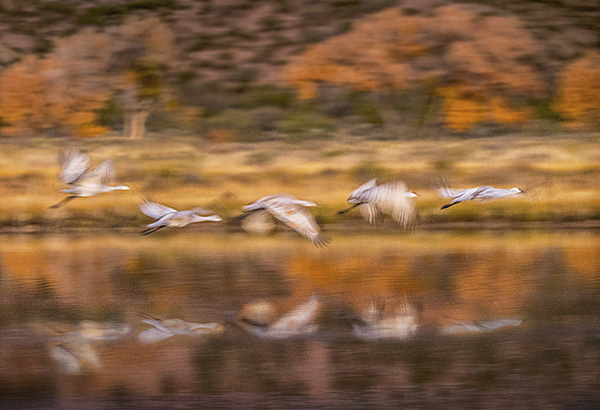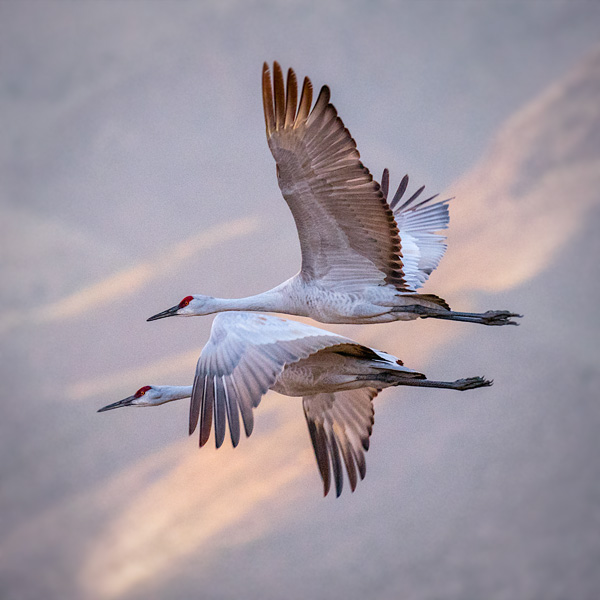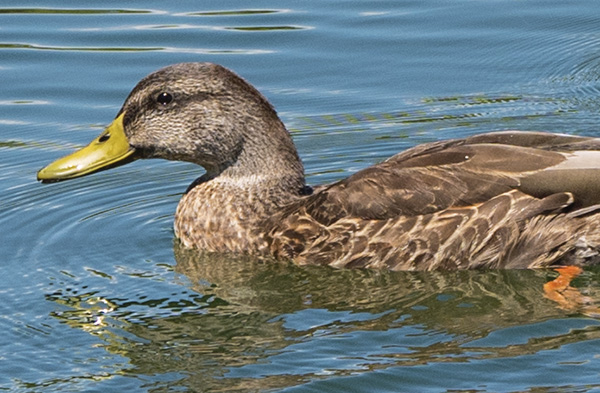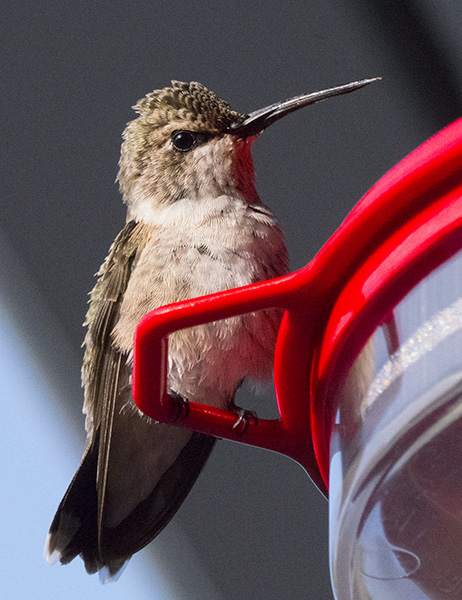
by successfulbob | bird photography, fine art photography, Lumix GX85, Lumix Lounge, wildlife photography
Bosque del Apache Wildlife Refuge – Part Four
Getting Artsy
When photographing a specific subject or area I always shoot for good solid captures at the beginning. After I know I’ve got some good work ‘in the can’, I see what I can do to push the creative ‘Artsy’ side. Here are some of those images.
Let’s look at some tracking flight images with the shutter speed set to a slow speed in this case most were at 1/250th sec. Images were captured handheld with the Lumix GX85 and the Lumix 100-400mm lens (200-800 35mm equivalent) Most were with the lens fully extended.
 Sandhill cranes photographed at takeoff panning with slow shutter speed.
Sandhill cranes photographed at takeoff panning with slow shutter speed.
 This technique adds lots of movement and an abstract feel to the images.
This technique adds lots of movement and an abstract feel to the images.
 Further into the art arena using additional post-processing techniques. MacPhun software Focus CK was used to bring more attention to the flight of the cranes.
Further into the art arena using additional post-processing techniques. MacPhun software Focus CK was used to bring more attention to the flight of the cranes.
 Cropped SOOC (straight out of camera) 1/40th SEC shutter speed.
Cropped SOOC (straight out of camera) 1/40th SEC shutter speed.
 Image from above worked with additional post processing.
Image from above worked with additional post processing.
 Canada Geese on a flyby 1/1600th SEC shutter speed.
Canada Geese on a flyby 1/1600th SEC shutter speed.
Experiment. Push. Play. Don’t be afraid to get an imperfect result in camera. Playing can lead to more interesting and personal image creations.
Let me know what you like, or don’t care for, in these images. I have an inquiring mind!
Yours in Creative Photography, Bob
Save
Save

by successfulbob | bird photography, Lumix GX85, photography gear, wildlife photography
Bosque del Apache Wildlife Refuge – Part Two
You can take a peek at part one on the Bosque Wildlife Refuge shoot here.
Made four total trips into the refuge which included a couple of sunrises and sunsets. Here’s a tip I’ve found to be handy when photographing in the same location multiple times. Download the images you capture as soon as you can for review. When you have a look, you can tell if any settings need adjustment. Nothing worse than making the same mistakes two days in a row and not finding out how you might have improved until you get back home. I’ve been a pro for over twenty years, and I still find slight improvements can be made when making images in the same location on subsequent days.
Let’s look at some tracking flight images captured handheld with the Lumix GX85 and the Lumix 100-400mm lens (200-800 35mm equivalent) Most were with the lens fully extended.
 Sandhill Crane in flight over the corn stalks.
Sandhill Crane in flight over the corn stalks.
 Flying into the corn field getting ready for landing.
Flying into the corn field getting ready for landing.
 Wings are flared to slow ascent.
Wings are flared to slow ascent.
 Opposite synchronization of wing position. Mountains in the background with just a streak of sun add interest to the image.
Opposite synchronization of wing position. Mountains in the background with just a streak of sun add interest to the image.
 Taking off from the cornfields heading toward the nighttime gathering area in the pond.
Taking off from the cornfields heading toward the nighttime gathering area in the pond.
There are many ways to capture a different ‘look’ to a wildlife photograph even though the subject matter is the same. In this case, the subject is Sandhill Cranes, but all the photos have a different feel. The different look is accomplished with a change in position of the subject. Using a different background. Changing the crop can make quite a difference also.
I’ll be sharing more options and possibilities for differences with the same essential subject in subsequent posts. I look forward to hearing your thoughts as I move through this series of with the Sandhill Cranes.
Yours in Creative Photography, Bob
Save
Save

by successfulbob | bird photography, Lumix GX85, photography, photography gear, wildlife photography
Bosque del Apache Wildlife Refuge – Part One
Talk about a target rich environment! Possibilities for incredible wildlife photography abound. The scenery, a variety of birds, and combinations of the two make for a great time photographing in this wildlife preserve about one and a half hours south of Albuquerque, New Mexico near Socorro. Learn more about the Bosque here.
This was my first visit, and I already look forward to returning in the future. Sandhill Cranes are a favorite bird for me to photograph. I have worked with them on the Gulf Coast of Florida. I’ve never seen groups this large. Since they are tanking up from traveling, they are pretty relaxed. They are chomping on rows of corn grown for them. The ponds are just the right depth for them to overnight and makes for interesting photographs as they fly in and out at dawn and sunset.
Let’s take a look at the photos.
This was one of the very first pictures I made when we got to the refuge. I am always trying to show the behavior of the animals when making images to add interest. Because I had previous experience wit the Sandhills, I recognized that this bird was about to leap. The fact that the other two birds are at the end of its wings was serendipity. Not the best time of day for photographing but we were checking out the area.
 Jumping Sandhill Crane
Jumping Sandhill Crane
 Sandhill Crane on a flyby through the field.
Sandhill Crane on a flyby through the field.
 Sandhill Cranes in the corn field planted for the migration as a feed stop.
Sandhill Cranes in the corn field planted for the migration as a feed stop.
 Getting ready for landing in the corn field.
Getting ready for landing in the corn field.
 Bob Coates (hey that’s me) Original photo made by my shooting partner on this trip, Dennis Chamberlain. Dennis is an incredible photographic artist. You can see some of his work here. (PS – I arted-up Dennis’s photo so don’t blame him for how it looks!)
Bob Coates (hey that’s me) Original photo made by my shooting partner on this trip, Dennis Chamberlain. Dennis is an incredible photographic artist. You can see some of his work here. (PS – I arted-up Dennis’s photo so don’t blame him for how it looks!)
Here’s some feedback on the gear that I used. I was testing out the Lumix 100-400mm lens with the Lumix GX85 to see how it would hold up to not being on a tripod. I’ve always tended to photograph birds in flight handheld because I could track their movement better but would often end up with more tossers than keepers due to blur. The dual image stabilization rocks! Total change with this gear. I’m very excited about the number of images I got that were keepers with this rig. You’ll see more of those in the next couple days.
Yours in creative Photography, Bob

by successfulbob | bird photography, Lumix GX85, Lumix Lounge, photography, photography gear, wildlife photography
Lumix GX85 Camera
I have only had this camera in my hands for a couple of days, and I’m liking it! The Lumix GX85 was built on the same chassis as the GX7. It’s a body that is small but very comfortable, in my opinion, to handhold. I remember when I took the GX7 out for a test spin about three years ago and didn’t like the feel of the grip when first using it. But as part of the Luminary Team, I was given the assignment to take the camera cross country and make images and send them out for two days. First half day I was uncomfortable with the camera’s feel. By the end of the first day, it was, “I kinda like this camera.” By the end of the second day, I was pleased and comfortable with the feel of the camera.
The other bonus was/is that this camera is very low profile. Combined with the smaller lenses of the micro 4/3rds system I found almost no one who said no to the request of making their picture. A decided difference from the equivalent full frame DSLR gear.
Fast forward to yesterday and photographing some wildlife. I was out scouting a wetlands area just south of Sedona. (who knew, right?) It was the middle of the day, and I wasn’t planning on making any images but just in case I set up the GX85 with the 100-300mm. The camera stabilization is fabulous, and the pictures I took are tack sharp. When photographing wildlife, I like precise detail and was excited by the results from handheld photos. It can be tough using a tripod when chasing flying critters around the marshes. This little guy is called the Flame Skimmer or Firecracker Skimmer for obvious reasons. I found chasing dragonflies is a lot like photographing birds in that you need to study behavior patterns to obtain well composed interesting images.
This little guy is called the Flame Skimmer or Firecracker Skimmer for obvious reasons. I found chasing dragonflies is a lot like photographing birds in that you need to study behavior patterns to obtain well composed interesting images.
 Here’s a detail of the dragonfly. A little bit of sharpening was added in post using MacPhun’s Creative Kit Focus
Here’s a detail of the dragonfly. A little bit of sharpening was added in post using MacPhun’s Creative Kit Focus
 Here’s the under-carriage of another dragonfly. Amazing little critters!
Here’s the under-carriage of another dragonfly. Amazing little critters!
 I moved to a different area with more water at a place called Bubbling Springs over in Page Springs and found this huge family of Mallards out for an afternoon swim.
I moved to a different area with more water at a place called Bubbling Springs over in Page Springs and found this huge family of Mallards out for an afternoon swim.
 Mallard duck detail.
Mallard duck detail.
Images were captured with the Lumix 100-300mm Vario f 4.0-6.3 lens. That’s a whole lotta reach for about $550 – Especially when you consider it’s the full frame equivalent of 200-600mm.
Yours in Creative Photography, Bob
PS – Can’t wait to try out the new Lumix G Leica DG Vario-Elmar 100-400mm Lens with this camera.
PPS – Please remember that using links to make your Amazon purchases helps to support this website. Cheers!
Save

by successfulbob | bird photography, Lumix GX8, Lumix Lounge, photography, photography education, wildlife photography
Hummingbird Photo – Lumix GX8
Hanging out this morning and thought I’d do some camera testing with my Lumix GX8 and the 100-300mm G Vario f4-5.6 (200-600mm equivalent) lens. I made these images handheld with stabilization turned on. Settings for these were f14 1/2000th sec at ISO 6400. I’ll share some hummingbirds in motion images at different settings a little later. I became enamored of this little critter because he had so much peppy personality. Looks like he just arrived from a long migration. He’s not one of our local birds and seems a little worse for wear.
 Hummingbird Straight out of the camera. He’s checking me out.
Hummingbird Straight out of the camera. He’s checking me out.
 After seeing me, he stuck out his tongue! Not sure if that was social commentary or not. Here’s the little guy after processing with MacPhun Noiseless and MacPhun Tonality (for sharpening the feathers just a bit more. Explanation below)
After seeing me, he stuck out his tongue! Not sure if that was social commentary or not. Here’s the little guy after processing with MacPhun Noiseless and MacPhun Tonality (for sharpening the feathers just a bit more. Explanation below)
So these images turned into a processing exercise. Some photographers mention that they are concerned with noise in images from smaller chip cameras like the micro 4/3rds. Personally, I feel that we get a little too hung up on that as the newer algorithms that are used in processing give a very natural feel to the noise that replicates the grain structure we had back in film days. (can you hear my creaky bones as I talk???)
To see if there was an elegant solution for those who have a concern when you push the camera to higher ISO’s thought I’d see how software might be of help. Oh man, it does if you are on a MAC. I’m using MacPhun Noiseless, and it worked a charm. MacPhun is only for MAC OS systems. I’m sure there are similar products for those on PCs. One of the problems I had in the past with noise reduction programs is the removal of detail that I wanted/needed in some parts of the image. I’ll let you decide, but I don’t think that’s a problem anymore!
On to the processing!
 Original detail capture SOOC.
Original detail capture SOOC.
 Here’s the image after running MacPhun’s Noiseless software. There are lots of settings and possibilities. This was a fairly aggressive treatment. It smoothed out the noise in the background nicely without losing detail in the feathers.
Here’s the image after running MacPhun’s Noiseless software. There are lots of settings and possibilities. This was a fairly aggressive treatment. It smoothed out the noise in the background nicely without losing detail in the feathers.
 This is the final. I used the Tonality software from MacPhun to sharpen the feathers a bit more. “Wait a minute Bob! isn’t tonality made for making an image black and white?” You bet. But, I liked the controls that allowed me to sharpen small details and micro control the contrast in different areas of the image. The secret is to do this on a separate layer and change the Layer Mode to Luminosity in Photoshop. Then only the information that is Luminous is applied to the image. Using a Layer Mask, I applied the sharpening to only the feathers.
This is the final. I used the Tonality software from MacPhun to sharpen the feathers a bit more. “Wait a minute Bob! isn’t tonality made for making an image black and white?” You bet. But, I liked the controls that allowed me to sharpen small details and micro control the contrast in different areas of the image. The secret is to do this on a separate layer and change the Layer Mode to Luminosity in Photoshop. Then only the information that is Luminous is applied to the image. Using a Layer Mask, I applied the sharpening to only the feathers.
 Here is the Tonality layer without a mask. You can see where it sharpened the background as well hence the use of the Mask in Photoshop in addition to changing to the Luminosity Mode.
Here is the Tonality layer without a mask. You can see where it sharpened the background as well hence the use of the Mask in Photoshop in addition to changing to the Luminosity Mode.
 Here’s the Layers Palette. Background Layer is original capture. Layer 1 is with noise removal. Top Layer is Tonality with a mask.
Here’s the Layers Palette. Background Layer is original capture. Layer 1 is with noise removal. Top Layer is Tonality with a mask.
Yours in Creative Photography, Bob
Save
Save
Save

by successfulbob | bird photography, black & white, fine art photography, imaging competition, photography, photography competition, photography creativity, wildlife photography
International Photographic Competition – Part 4
Change is in the air!
Due to a change in this year’s judging procedure, I can share my Loan Collection images from the International Photographic Competition (IPC) put on by Professional Photographers of America (PPA). The PPA Loan Collection is judged after a picture has earned a Merit, which is defined as an above average image by an above average photographer. Loan Collection images are considered among the ‘Best of the Best.’
And here we go. I’ll comment under each image for what I was trying to accomplish.
 “Going Up” – A study in perspective. Trying to make an everyday object into an art piece. I do this in practice for my commercial and architectural clients.
“Going Up” – A study in perspective. Trying to make an everyday object into an art piece. I do this in practice for my commercial and architectural clients.
 “Dance of the Snowy Egret” – This was me on vacation. I was studying this snowy egret tracking down its meals in the marsh. I noticed some patterns as I watched its behavior. This image began to form in my head. The Master Artist category is judged on the final output. Also, the difficulty and expertise in applying the techniques is a major part of whether an image is accepted.
“Dance of the Snowy Egret” – This was me on vacation. I was studying this snowy egret tracking down its meals in the marsh. I noticed some patterns as I watched its behavior. This image began to form in my head. The Master Artist category is judged on the final output. Also, the difficulty and expertise in applying the techniques is a major part of whether an image is accepted.
 “Shape Form Tone” – Made in Atlanta while I was a PPA headquarters for a meeting. We were on break, and I had brought a camera with me and saw this view out the window. Again, working on perfecting my craft by creating depth and dimension in my work.
“Shape Form Tone” – Made in Atlanta while I was a PPA headquarters for a meeting. We were on break, and I had brought a camera with me and saw this view out the window. Again, working on perfecting my craft by creating depth and dimension in my work.
 “Iris” – This was a design I created for a silk scarf. (my clothing designs are available at SHOP VIDA) Depth and dimension are critical to adding life to a two-dimensional surface. Shadows are essential in making that happen.
“Iris” – This was a design I created for a silk scarf. (my clothing designs are available at SHOP VIDA) Depth and dimension are critical to adding life to a two-dimensional surface. Shadows are essential in making that happen.
There you have it. My photographic and design work in the 2016 PPA Loan Collection as judged by Professional Photographers of America.
Yours in Creative Photography, Bob

 Sandhill cranes photographed at takeoff panning with slow shutter speed.
Sandhill cranes photographed at takeoff panning with slow shutter speed. This technique adds lots of movement and an abstract feel to the images.
This technique adds lots of movement and an abstract feel to the images. Further into the art arena using additional post-processing techniques. MacPhun software Focus CK was used to bring more attention to the flight of the cranes.
Further into the art arena using additional post-processing techniques. MacPhun software Focus CK was used to bring more attention to the flight of the cranes. Cropped SOOC (straight out of camera) 1/40th SEC shutter speed.
Cropped SOOC (straight out of camera) 1/40th SEC shutter speed. Image from above worked with additional post processing.
Image from above worked with additional post processing. Canada Geese on a flyby 1/1600th SEC shutter speed.
Canada Geese on a flyby 1/1600th SEC shutter speed.


































